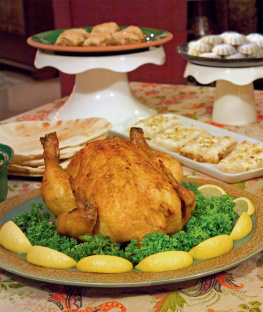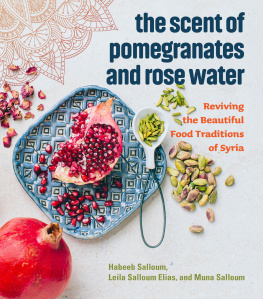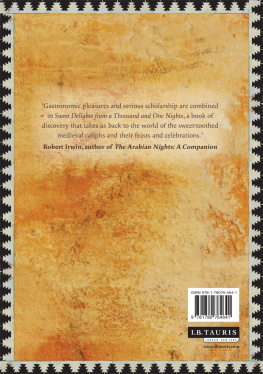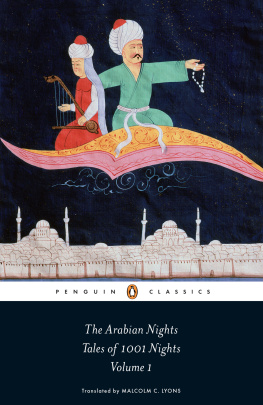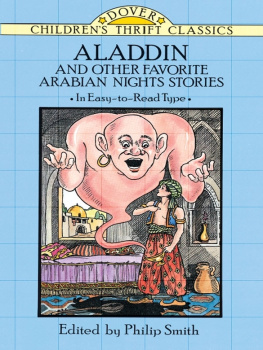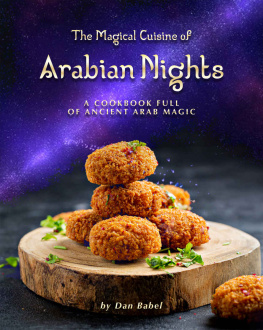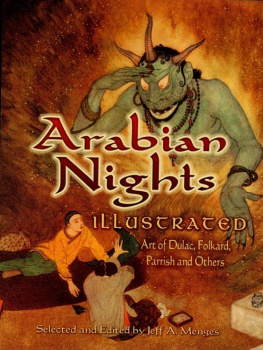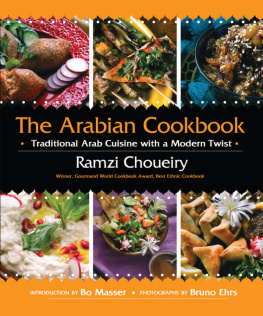ACKNOWLEDGMENTS
First, I wish to especially thank my daughters Leila Salloum Elias and Muna Salloum who encouraged me to write this modest work. Also, I want to thank them for their valuable advice about the recipes, for providing the historical background to some of the foods and for helping to test and taste a number of the dishes.
Also, I wish to thank the men and women who I talked to in the Arab Gulf countries and other parts of the Arab world who gave me valuable information about their ways of life and cuisine. Further, I want to thank family, friends and colleagues who gave me constructive feedback about the food dishes that I had created. After tasting my recipes, their good opinions have confirmed my belief that I had indeed re-created the authentic tastes and aromas of the Arab Gulf at my own table.
In addition, I wish to thank those authors whose books widened my horizon on the Arab Gulf nations and provided interesting quotable material, which Ive sprinkled throughout the book.
Guiding me through the maze of fine-tuning the text of my book for publication was my editor, Holly Jennings. She was always pleasant and helpful during our discussions on the various matters relating to this book, and her dedication and enjoyment of the topic is exemplary, making it a joy to have had the opportunity to work with her.
Basic Recipes
This section is the place to find recipes for popular condiments and pickles; Arabian Gulf Spice Mix, or Baharat (page )two thick, creamy cream cheeselike yogurt products that are extremely addictive and easy to make. Like several other dishes in this book, Creamy Yogurt Spread and Labana Balls have been adopted from their countries of origin, the Greater Syria area and Iraq, by the people of the Arab Gulf nations, where they are enjoyed throughout the dayat breakfast, as snacks and as part of a meal.

Crunchy Pickled Garlic
Ajar Thoom Al-Ajam
An essential part of most meals in the Middle East, pickles are popular throughout the region. Over the years, the Arab Gulf countries have embraced the pickle-eating traditions of the Greater Syria region, Iraq and Iran, where pickled turnips, eggplants, cauliflower, carrots and especially, garlic, are the favorites. Of all of these, my favorite is pickled garlic, an exotic, tangy and spicy pickle that is Iranian in origin. Crunchy Pickled Garlic not only spices up a meal (it goes especially well with meat or chicken dishes), it also makes for a great appetizer. This recipe makes a large amount, but pickled garlic has amazing keeping powers! Culinary writers have said that pickled garlic improves with agesome make the unbelievable claim they will keep as long as fifteen years. I have stored pickled garlic for as long as 4 months in the refrigerator and was still eating from them long after. They stayed as tasty and crunchy as when I first made them. But fifteen years? This would be pretty hard to imagine because once one starts with one pickled clove of garlic, it will be difficult to resist a second and a third.
Makes 2-quarts (2 liters)
Prep time:1 hours (and MUCH less withthe help of friends or family)
Cooking time:15 minutes
Maturing time:3 days
2 lbs (1 kg) garlic, cloves separated and peeled
1 cup (250 ml) white vinegar
1 cup (250 ml) water
4 tablespoons sugar
1 tablespoon salt
1 tablespoon whole coriander seeds
12 peppercorns
6 whole cloves
2 teaspoons dried red pepper flakes
2 teaspoons ground turmeric
teaspoon dried tarragon
teaspoon dried marjoram
teaspoon dried thyme
Boiling water
Place all the ingredients in a large saucepan and bring to a boil. Cover and cook over medium-low heat for 8 minutes.
Immediately pour the garlic-vinegar mixture into a 2-quart (2-liter) heatproof jar and top off with boiling hot water. Cover with a tight-fitting lid and let stand in a cool, dark place for at least 3 days before serving. Store what is not used in its brine in the refrigerator for future use.
Tangy Hot Tomato Sauce
In the modern Arab Gulf countries, this spicy and hot sauce, a vegetarian delight, is served with all types of rice dishes or with cooked meats and vegetables. However, in the past, when most of the people in the Arab Gulf states were poor, it was served as a replacement for meat to give rice a delicious flavor. My first introduction to this sauce was at a hotel restaurant in Dubai where a number of dishes were placed on the table as appetizers. Adhering to the old Arab tradition of dipping and scooping bread into the dip-able dishes, we scooped away until we had finished off the delicious Tangy Hot Tomato Sauce even before the main course arrived.
Makes 1 cups (300 ml)
Prep time:5 minutes
Cooking time:15 minutes
4 tablespoons tomato paste
1 cup (250 ml) water
4 cloves garlic, crushed to a paste (see page )
1 teaspoon ground cumin
teaspoon ground red pepper (cayenne)
1 tablespoon vinegar
2 tablespoons extra-virgin olive oil
Salt to taste
Thoroughly combine all the ingredients in a small saucepan with a lid. Bring to a boil.Cover and cook over low heat for 10 minutes, stirring occasionally.
Remove from the heat and allow to cool. If the sauce is too thick, add a little water. (It should have the consistency of tomato sauce.)Store in a covered glass container in the refrigerator. It should be used within a week.
Creamy Garlic Sauce Taratoor
This delicious garlic sauceit enhances everything it touches!was first prepared by peasants in the Greater Syria region. From there it was carried by the Phoenicians and later the Arabs to the Iberian Peninsula, and from there it moved up to southern France, where it is called aioli. This sauce and other similar garlic sauces are today an integral part of the Arab Gulf countries cuisines. This sauce, an international favorite, goes great with all types of chicken, fish, meat and vegetable dishes. I especially enjoy it with barbecued fish. For those who fear too much garlic on the breath, this sauce may seem a little overpowering. Fear notone taste will take your breath away! Even children will love it! (One of my grandchildren spreads this sauce on toast for his morning getter-upper.)
Makes about 1 cup (250 ml)
Prep time: 15 minutes
1 large head garlic, cloves separated and peeled
1 egg
1 teaspoon salt
cup (125 ml) extra-virgin olive oil
2 tablespoons freshly squeezed lemon juice
Process the garlic, egg and salt in a blender for a few moments. With the motor running, slowly pour in the oil. After all the oil is added, continue to blend for 1 minute.
Add the lemon juice and blend until a frothy sauce is formed. Place in a small serving dish or bowl and serve immediately.
Orange Blossom Syrup Sheera
This syrup is responsible for the divinely sweet taste of many Arab pastries. Also known as Qatar or Atar, it is used throughout the Middle East for the same purpose. Sheera is a sugar- and water-based syrup flavored with orange blossom water. As one travels westward in Arab North Africa the syrup used there for sweets, in most cases, is honey based, though it is also flavored with orange blossom water. For a change of taste, the orange blossom water can be replaced with rosewater. We usually have a few cups of this sweet syrup on hand in case someone in the family craves a waffle or pancake with a touch of the Arab Gulf.

